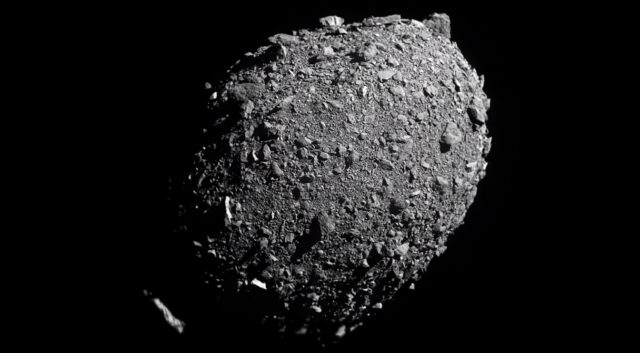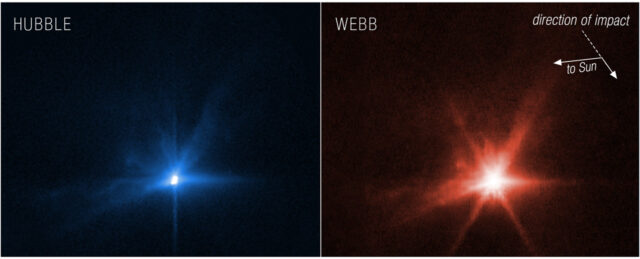Images of DART Impact Show the Differences Between Webb and Hubble

NASA made history last week when it successfully crashed the DART spacecraft into an asteroid in the first-ever demonstration of potential planetary defense technology. That occasion was momentous for another reason — it was the first time the shiny new James Webb Space Telescope (JWST) observed the same object at the same time as the venerable Hubble Space Telescope.
It’s a foregone conclusion that a large asteroid will have Earth in its sights someday. The geological record is filled with evidence of past impacts. For the first time, humanity might have the necessary technology to avert disaster. DART, or the Double Asteroid Redirection Test, will help scientists better understand what it would take to knock an asteroid off course, and detailed observations of the effects are vital to that effort.
Thus, NASA turned its two Great Observatories toward the binary asteroid pair of Didymos and Dimorphos on Sept. 26. Even after more than three decades, Hubble is an incredible tool thanks to its position outside the planet’s murky atmosphere. It operates in the visual spectrum, which shows “rays” of ejecta flying away from the asteroid following impact. Astronomers estimate the brightness of Dimorphos increased by three-fold after the probe hit. Some of the rays also appear to be curved — no one is quite sure what that means yet. Hubble will check in with the asteroid ten more times over the coming weeks as the dust settles.

For the first time, NASA’s James Webb Space Telescope and Hubble Space Telescope have taken simultaneous observations of the same target.
The JWST has only been operating for a few months, but it’s already the most advanced telescope ever built. Webb captured images of the asteroid for several hours on Sept. 26, but unlike Hubble, Webb operates in the infrared part of the spectrum. The impact appears in Webb data as a tight, compact point of light with plumes of ejecta streaming away from the impact site. Webb will also turn its attention to Dimorphos several times over the next few months to assess how the object has been altered by DART’s impact.
There are still a lot of unknowns when it comes to asteroid defense. In just the last several years, we’ve seen our first up-close look at asteroids, and there have been some surprises. It may turn out that these objects behave more like giant piles of gravel than monolithic rocks, and that could change how we steer them away from Earth. DART, and the observations from Earth’s most powerful telescopes, will help make that important determination.
Now read:

Comments are closed.